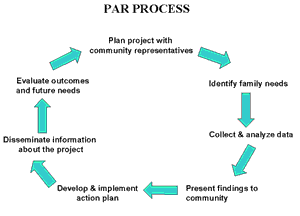Partnerships have been central to our projects as we have worked together with American Indian families, community leaders, and health care providers to improve the quality of life and health care for American Indian children. We have included community representatives in all phases of the project to make sure that the project addresses community needs. A primary goal has been to give back to the community, so families and community representatives have been the first to learn about the project findings at community gatherings. In response to community needs, we developed educational resources to increase the awareness of asthma in the community and increase the cultural awareness of health care providers who work with American Indian children and their families.
We have used a participatory action research (PAR) approach in our projects because it has a good cultural fit and provides ways to give back to the community. The PAR framework involves research that is (a) community based, (b) action-oriented, and (c) collaborative. PAR focuses on developing partnerships and collaborations to increase the relevance of research for the researcher, consumers and stakeholders. This approach also provides understanding about an issue within the context of the community while increasing the community's understanding of the issue.
To implement this PAR approach, leaders from community organizations that serve American Indian children and families were actively involved in the design, recruitment, and implementation of the Indian Family Stories Project. The graph illustrates the PAR process we have used:
